














Approved and Adopted by the Board of Directors December 15, 2022
Thank you to all our partners who collaborated with us to assess the needs of our communities.
Nassau County Department of Health
Irina Gelman, DPM, MPH Commissioner of Health
200 County Seat Drive, North Entrance
Mineola, NY 11501
(516) 742-6154
Coalition: The Long Island Health Collaborative (LIHC) is a coalition of the region’s hospitals, local health departments, academic institutions, community-based organizations, medical societies, health plans, clinics and others dedicated to improving the health of all Long Islanders. The LIHC is overseen by the Nassau-Suffolk Hospital Council, the association that represents Long Island’s hospitals The LIHC provided oversight and management of the Community Health Needs Assessment processes, including data collection and analysis. This is done on behalf of the Long Island region (Nassau and Suffolk counties).
This Community Health Needs Assessment (CHNA) represents a collaboration between Catholic Health, the Long Island Health Collaborative (LIHC), local community-based agencies, patients living in our community and the Nassau County Department of Health. Catholic Health retained DataGen in the summer of 2022 to provide research analysis to facilitate this report, which defines the identified community health needs and barriers expressed by community members and the local community-based organizations that serve the region. This report’s primary data was collected by the Long Island Health Collaborative from January 2021 through August 2022. It includes input and comments from community members and community leaders. The secondary data used is from years 2018 – 2021. The results from multiple analyses will enable Catholic Health to deploy new and existing chronic disease prevention strategies, address relevant social determinant of health risk factors, and work to reduce the health disparities identified. The COVID-19 pandemic placed a stark spotlight on health inequities in this region and this has reinforced Catholic Health’s enduring mission to bring health and social care to all communities. St. Joseph, one of six hospitals in the Catholic Health system, is located in Bethpage, New York and provides comprehensive inpatient, outpatient, emergency, critical care and surgical services.
At Catholic Health, we are dedicated to addressing the significant health needs of the communities we serve. Catholic Health’s six hospitals continue to build community health services and education programs in five core areas: chronic disease management, providing mental health services, treating and reducing substance use disorder, preventing communicable diseases and addressing the social determinants of health. In partnership with our community members and local nonprofits, churches, schools, and health departments, we are creating a healthier community, one patient at a time.
St. Joseph, along with Catholic Health’s other five hospitals, worked with the Long Island Health Collaborative (LIHC) and the Nassau County Department of Health (NCDOH), and dozens of community-based organizations, libraries, schools and universities, local municipalities, and other community stakeholders to produce this CHNA. NCDOH representatives offered input and consultation, when appropriate, regarding the data analyses conducted by the LIHC and DataGen. Top, high-level findings include a continued prevalence of chronic disease incidence, particularly heart disease and diabetes, obesity, and cancer. Further, surging rates of mental health and substance misuse issues among all demographic categories, with disparity seen among youth, and low-income communities of
color continuing to experience a higher burden of disease overall. In 2022, members of the LIHC reviewed extensive data sets selected from both primary and secondary data sources to identify and confirm New York State Prevention Agenda priorities for the 2022-2024 Community Health Needs Assessment cycle. Data analysis efforts were coordinated through the LIHC, which served as the centralized data return and analysis hub. As directed by the data results, community partners selected:
1. Prevent Chronic Disease
Focus Area 4: Chronic Disease Preventive Care and Management
2. Promote Well-Being and Prevent Mental and Substance Use Disorders
Focus Area 2: Mental and Substance Use Disorders Prevention
Primary data was obtained from a community health needs assessment sent to individuals and a similar survey to community-based organization leaders1. Additionally, we looked at results from two qualitative studies to round out our primary data.2 Secondary data was derived from publicly-available data sets curated by DataGen into its proprietary data analytics platform, CHNA Advantage ™ , offering 200 plus metrics to determine health issues within Nassau County.3 As such, priorities selected for the 2022- 2024 cycle remain unchanged from the 2019 – 2021 cycle selection, and the selected health disparities in which partners are focusing their efforts rests on the inequities experienced by those in historically underserved communities and communities of color. Additional Prevention Agenda priorities/disparities being addressed by St. Joseph are outlined in the 2022-2024 work plan (See Appendix E).
St. Joseph works with a broad range of partners to connect with the community, to assess their needs through distribution and promotion of data collection tools, and to provide interventions in collaborative settings, when appropriate. See page 9 for our extensive list of partners. We also rely on the LIHC and its role as neutral convener and regional leader, espousing the collective impact model and framework.4 As such, the LIHC serves as a backbone organization, providing its diverse partners with data analytics and administrative support in the areas of community outreach and education, and media relations support. LIHC’s networking capabilities, its programs around walking and chronic disease awareness, and health messaging efforts reinforce and augment the interventions
1 Community Health Assessment Survey (CHAS) assessing responses from individuals, summary report and survey instrument (Appendix A) CBO Survey Analysis 2022, assessing responses from community-based organization leader, summary report and survey instrument (Appendix B)
2 Qualitative Analysis of Key informant Interviews Conducted among Community-Based Organization Leaders (Appendix C) Long Island Libraries: Caretakers of the Region’s Social Support and Health Needs: Qualitative Analysis (Appendix D)
3 Statewide Planning and Research Cooperative System (SPARCS), New York State Prevention Agenda dashboard, Behavioral Risk Factor Surveillance System (BRFSS), Extended Behavioral Risk Factor Surveillance System (eBRFSS), New York State Community Health Indicators by Race/Ethnicity Reports, Community Health Indicator Reports, Prevention Quality Indicators, CDC Places, and U.S. Census Bureau. The CHNA Advantage™ data analytics platform includes these and other state and national level indicators. It also encompasses social risk measures offered by Socially Determined, Inc.
4 https://collectiveimpactforum.org/
we provide in the chronic disease and mental health needs spaces so that we are continually in touch with the broader community. See Appendix F for a list of LIHC partners.

Source: Healthcare Association of New York State (2020 Community Benefit)
Nassau County’s total population as of 2020 is 1,395,774 (47.3% male; 49.8% female). Those ages 15-44 represent 35.1% of females; 37.5% of males; ages 60 plus represent 22.6% of males and 26.6% of females; 18 plus represent 77.3% of males and 79.5% of females
The region is predominately White at 58.5% with 10.9% Black/African American (a decrease from 11.5% last report) and 11.7% Asian (up from 9.1%). Hispanic or Latino represent 18.3% of the population5, a two percent increase from the last report.
Interestingly, according to the Robert Wood Johnson Foundation’s 2022 County Health Rankings,6 Nassau County ranks fourth for health outcomes and first for health factors. Health factors represent health issues that can improve length and quality of life. Health outcomes represent how healthy a county is right now.
Nassau County is situated east of New York City and spans 453 miles. It is one of two counties that comprise Long Island, the eastern-most part of New York State. Nassau County is comprised of two cities: Long Beach and Glen Cove and three townships: Hempstead, North Hempstead, and Oyster Bay Long Island is bounded on the north by Long Island Sound and on the east and south by the Atlantic Ocean. The west of the county is joined to Queens County and Kings County (or Brooklyn). These are two of the five boroughs of New York City. In addition to Nassau County, Catholic Health serves patients in eastern Queens and parts of western Suffolk County.
In terms of income, 31% of the population earn less than $74, 999 (up from 26.5% in the last report) with 13.5% of that group earning less than $34,999 annually. Of the population, 6.2% of those under 18 years of age live in poverty, while 5.1% of those ages 18 to 64 live in poverty and for those ages 18 to 34 years of age, 6.4% live in poverty.7 The percentage of the population (5 years and over) that speaks a language other than English at home is 28.8%, with Spanish the dominant other language spoken (12.8%) followed by other Indo/European languages (9.9%) and Asian languages (4.9%). In terms of education, for those age 25 and over, 91.6% are high school graduates or higher, 46.7% hold a bachelor’s degree or higher. The percent of the total population uninsured is 4.1%. Of that percent, non-citizens represent 36.3%, Hispanic Latino (43%) and Black/African American (13.6%), Asian (12.8%) and White (43.2%). Of the uninsured, 40.4% earn less than $74,999 household income and 10.1% earn under $25,000 household income. Approximately 8.5% of the total non-institutionalized population is disabled. By race/ethnicity, 11.4% of the Native Hawaiian/Pacific Islander population is disabled, 10.8% of the American Indian/Alaska Native population is disabled, 9.7% of the White population is disabled, 5.4%
5 U.S. Census Bureau, 2020 Decenniel Census
6 https://www.countyhealthrankings.org/reports/2022-county-health-rankings-national-findings-report
7 U.S. Census Bureau, 2016-2020 American Community Survey, Five-Year Estimate
of the Hispanic Latino population is disabled and 7.1% of the Black/African American population is disabled. Interestingly, Native American/Pacific Islanders account for less than one percent of the county’s population 8
Income – one social determinant of health – precludes individuals from low-income communities from accessing preventive and/or medical care due to their difficulty to afford co-payments/deductibles (if insured) or care at all if they are uninsured. The inability to afford co-pays and deductibles consistently rises to the top as a barrier to health care on the LIHC’s Community Health Assessment Survey year after year. The median household income in the past 12 months by race is $124,300 (White), $105,331 (Black), $95,890 (Hispanic/Latino). Mean income for the past 12 months per capita by race is $60,972, $38,622 and $31,976, respectively.9 This is why income is such a driving factor for health disparity and why the region has selected to focus on interventions and strategies that level the playing field for communities that are pockets of poverty in a rather affluent region.
Municipalities in target community
St. Joseph’s primary service area is Nassau County, but the hospital also serves patients from eastern Queens and western Suffolk. The chart below defines the zip codes and municipalities (towns) comprising St. Joseph’s service area.

Nassau County is unique in that it presents complex polarity, representing a wide range of both healthy and sick community members from opposite ends of the health spectrum. There are eight select communities in which a variety of socioeconomic factors lead to vast health disparities. These select communities were determined by the Nassau County
8 U.S. Census Bureau, 2016-2020 American Community Survey, Five-year Estimates
9 U.S. Census Bureau, 2016-2020 American Community Survey, 5 Year Estimates
Department of Health with concurrence from hospital partners. These communities are: Freeport, Hempstead, Inwood, Westbury, Roosevelt, Uniondale, Elmont, and Glen Cove. Catholic Health and its partners continue to concentrate efforts in these select communities.

Source: Profiles Map | Nassau County, NY - Official Website (nassaucountyny.gov)
Health behaviors, outcomes, and social determinants of health indicators in the chart below compare St. Joseph’s key outreach communities.
CHNA Advantage™ Analytics Platform
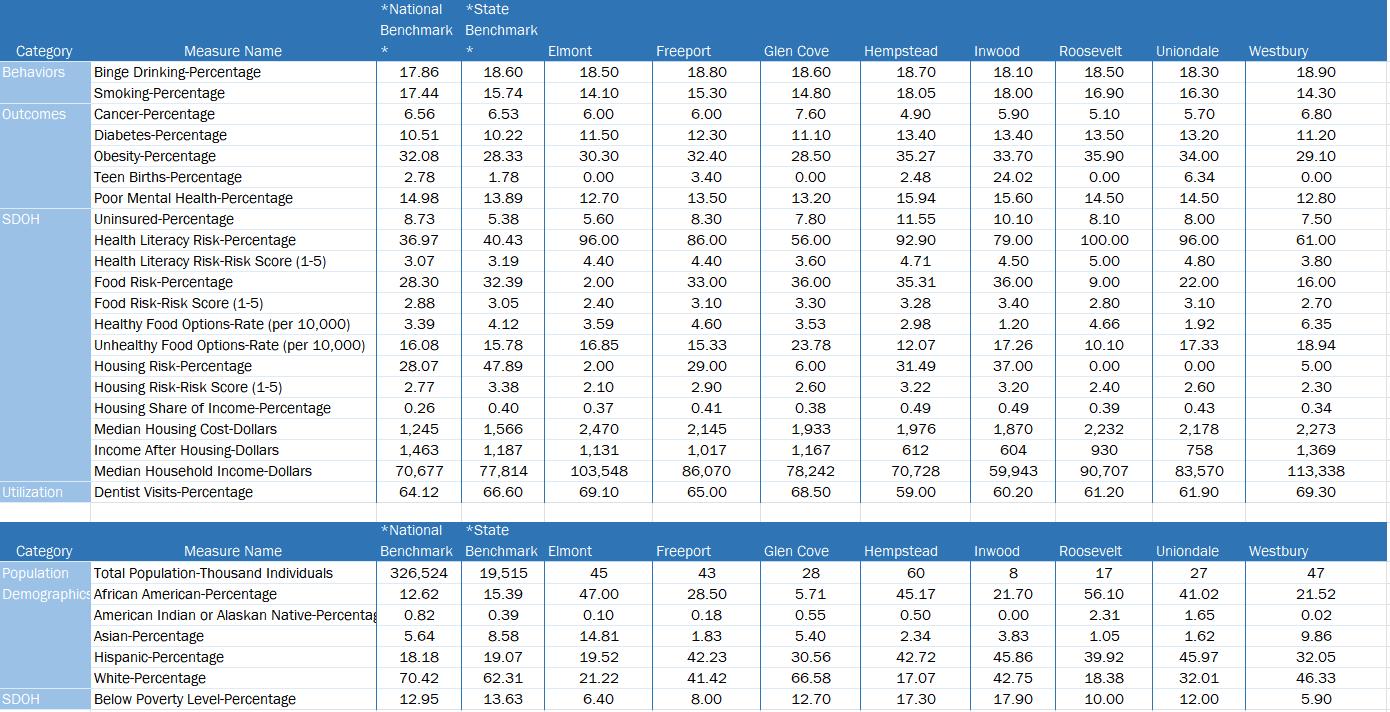
DataGen Analytics Platform. 2018-2020 Eight Select Communities, Health Outcomes Compared to New York State and National Benchmarks
As part of our collective impact strategies to promote health and well-being for residents in our communities, St. Joseph has strong relationships with local and regional communitybased organizations, libraries, schools, faith-based organizations, the local health department, local fire departments and municipalities that support and partner with us to reduce chronic disease, mental health and substance misuse, and to promote health equity. Following is an extensive partner list of health care and other key institutions.
Adelphi University Breast Cancer Hotline & Support Program (Sisters United in Health(
American Cancer Society
American Diabetes Association
American Heart Association
American Lung Association
American Parkinson Disease Association
Bethany House
Bethpage Chamber of Commerce
Bethpage Library
Bethpage School District
Bishop McHugh Health Center
Book Fairies
Brady Park Senior Center
Cancer Services Program of Nassau County
Catholic Charities
Catholic Faith Network (formerly Telecare TV)
Catholic Health, Melville
Catholic Health Home Care, Farmingdale
Cancer Services Program of Nassau County
Central Park Historical Society, Bethpage
Cherry Lane Elementary School, Carle Place
Family and Children’s Association (SHERPA)
Fidelis Care
Fire Departments: Levittown, Massapequa, North Bellmore, Bellmore, North Massapequa, North Merrick, Bethpage, Farmingdale, Hicksville, Plainview, Westbury, South Farmingdale, Wantagh, Copiague, Amityville, Lindenhurst
Gerald J. Ryan Outreach Center, Wyandanch
Gift of Life, Inc.
Good Samaritan University Hospital, West Islip
Good Samaritan Nursing & Rehabilitation Care Center, Sayville
Good Shepherd Hospice, Farmingdale
Health and Welfare Council, LI
High School for Construction Trades Engineering and Architecture
Island Harvest, numerous sites throughout Nassau County’s select communities
JASA Long Beach & Jamaica, NY
Jewish Community Center
Long Island Health Collaborative (LIHC)
King Kullen Bethpage
The Knolls in East Meadow
Leukemia and Lymphoma Society
Levittown United Teachers
Levittown YES Community Center
Lindenhurst library
Long Island Blood Services
Long Island Cares
Long Island Health Collaborative
Louis J. Acompora Memorial Foundation
Magnolia Gardens, Westbury
Mental Health Association of Nassau County
Mercy Hospital, Rockville Centre
Merrick Library
Nassau Community College Health Fair
Nassau County Department of Human Services, Office of Mental Health, Chemical Dependency, Developmental
Nassau County Police Medics
New York Institute of Technology College of Osteopathic Medicine, Old Westbury and Central Islip
New York State Department of Transportation Health and Safety –Sunken Meadow Park, Kings Park
North Hempstead, YES Community Center, Westbury
North Massapequa Community Center
Our Lady of Consolation Nursing and Rehabilitation Center, West Islip Our Lady of Fatima, Manorhaven
Our Lady of Good Counsel Church, Inwood
Our Lady of Loretto Church, Hempstead
Our Lady of Mercy Academy
Queen of the Most Holy Rosary Church
Society of St. Vincent de Paul
South Bay Cardiovascular
St. Brigid Church, Westbury
St. Brigid Senior Center, Westbury
St. Catherine of Siena Hospital, Smithtown
St. Catherine of Siena Nursing & Rehabilitation Care Center, Smithtown
St. Charles Hospital, Port Jefferson
St. Killian Church, Farmingdale
Stony Brook Medicine/Creating Healthy Schools and Communities
Sustainable Long Island, Creating Healthy Schools and Communities
The Oaks Senior Center
Town of Hempstead Project Independence Center, Hempstead
Town of Oyster Bay
Westbury Memorial Library, Westbury
Western Suffolk BOCES /Creating Healthy Schools and Communities
YAM Community Resource, Inc. Huntington Station
St. Joseph relies upon the LIHC to disseminate information about the importance of proper nutrition and physical activity among the general public to assist Nassau residents in better managing their chronic diseases and/or preventing the onset of chronic diseases. St. Joseph also relies upon the LIHC to disseminate information about mental health prevention and treatment services and programming, as well as relevant information about substance misuse. Dissemination of information is achieved through the bi-weekly Collaborative Communications e-newsletter, which is sent to 588 community-based organization leaders, and strategic use of social media platforms. These efforts are ongoing. The work plan (see Appendix E) outlines anticipated measures and activities for 2023 supported by the LIHC. Finally, St. Joseph participates in the LIHC’s quarterly stakeholder meetings and avails itself of LIHC’s extensive network. See Appendix F for a list of partners. A representative from the Nassau County Department of Health also participated in the monthly 2022 CHNA Workgroup – September 2021 – April 2022 (See Appendix G for list of workgroup members).
Low-income communities of color, especially the identified eight select communities, bear a greater burden of chronic disease, which is exacerbated by social determinant of health need factors.
Financially stressed individuals have difficulty affording nutritious foods, leaving them more vulnerable to poorer chronic disease management outcomes, since nutrition and diet play
a pivotal role in every chronic disease. This is one of the reasons why Catholic Health has embarked on new food insecurity initiatives with community partners Long Island Cares, Catholic Charities, and the Health and Welfare Council of Long Island.

Catholic Health is also collaborating with Catholic Charities and Health and Welfare Council of Long Island to enroll individuals and families identified as food insecure in the Supplemental Nutrition Assistant Program (SNAP).
According to Feeding America, 5.7% of Nassau County residents are food insecure, which represents 77,750 community members. Another Feeding America study, Map the Meal Gap 2020, examined the cost of food and cost of living in zip codes across the United States. Nassau County’s Annual Food Budget Shortfall represents $50,557,000, according to the study, and 44% of adults are living above the 200% federal poverty level for SNAP.10
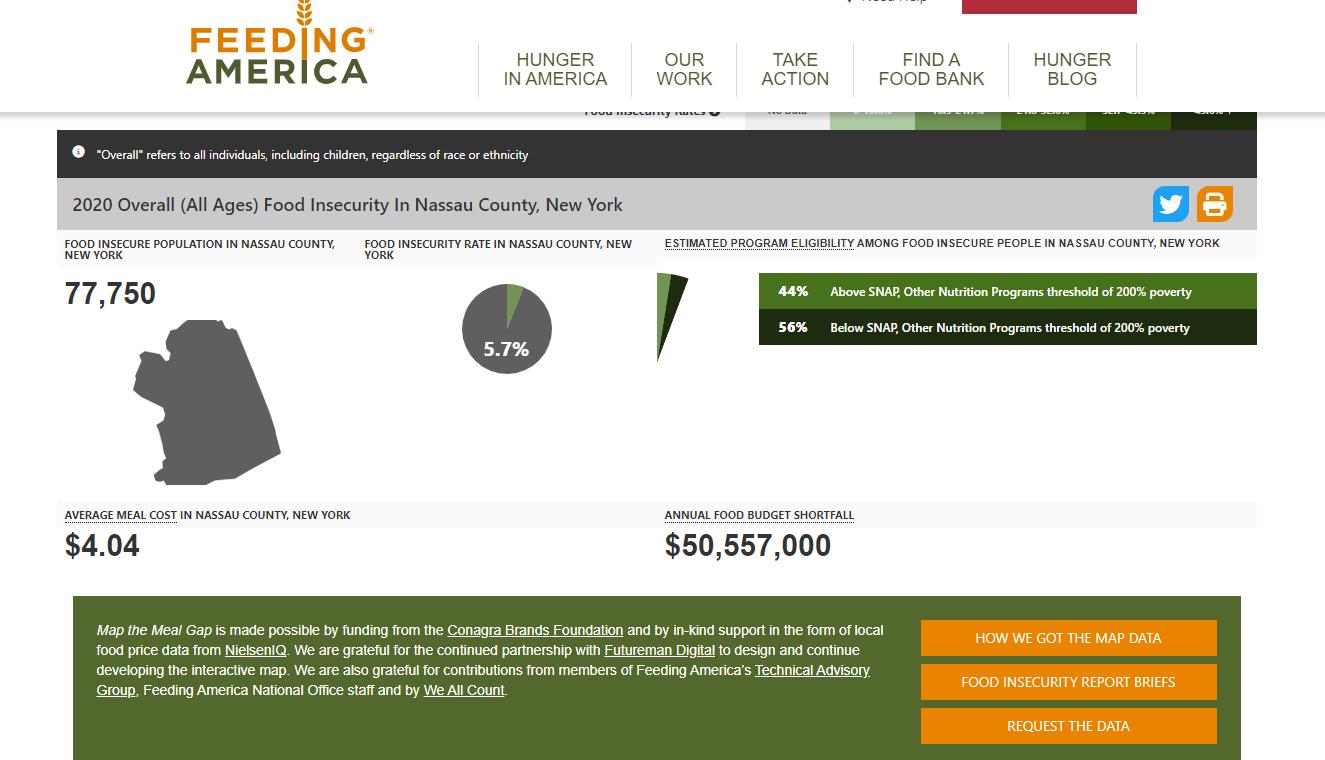
10 Feeding America. Map the Meal Gap 2020. Nassau County, New York. Retrieved 9/20/22. https://map.feedingamerica.org/county/2020/overall/new-york/county/nassau
Through the CHNA process, reducing chronic diseases and mental health illness/substance misuse have been identified as the top two priorities in our communities. Embedded within these priorities are areas of need, which the primary and secondary research revealed.
Access to care, health literacy, education, economic security (poverty), obesity and weight loss, food access, clean air and water.
Primary data and secondary data demonstrate that residents living in Nassau County and Suffolk County are experiencing poor mental health status. The 2021 Robert Wood Johnson Foundation County Health Rankings examining New York counties Nassau and Suffolk in Quality-of-Life Health Outcomes demonstrates an average of 3.7 poor mental health days per 30 days for Nassau County residents and 4.0 poor mental health days per 30 days in Suffolk County. 11
Mental health issues have soared in the past two years, spurred in part, by the effects of the pandemic. Using data from the U.S. Census Bureau’s COVID-19 Household Pulse Survey (April 23, 2020 – October 26, 2020), a New York State Health Foundation analysis found that more than one-third of adult New Yorkers reported symptoms of anxiety and/or depression, with racial and ethnic groups of color as well as low-income New Yorkers, reporting the highest rates of poor mental health.
However, the 18 – 34-year-old age group reported the highest rates (49%) of poor mental health.12 High school students (grades 9 through 12) fared just as worse. A number of studies found poor mental health along with suicide ideation intensified during the pandemic for high schoolers, especially among females. An April 2022 analysis of data from the 2021 Adolescent Behaviors and Experiences Survey revealed that 37.1% of students experienced poor mental health during the pandemic, and 31.1% experienced poor mental health during the preceding 30 days.13 The pandemic made a bad situation worse, especially for youth, as mental health issues and suicides were already increasing prior to the COVID-19 Pandemic.14 15 16 17 With the shortage of mental health care workers and the
11 https://www.countyhealthrankings.org/app/new-york/2021/compare/snapshot?counties=36_059%2B36_103
12 https://nyhealthfoundation.org/resource/mental-health-impact-of-the-coronavirus-pandemic-in-new-yorkstate/#:~:text=The%20proportion%20of%20New%20Yorkers,health%20throughout%20the%20survey%20period
13 https://www.cdc.gov/mmwr/volumes/71/su/su7103a3.htm?s_cid=su7103a3_w
14 https://www.cdc.gov/mmwr/volumes/66/wr/mm6630a6.htm
15 https://www.cdc.gov/nchs/fastats/mental-health.htm
16 Weinberger, A. et al. (August 2017) Trends in depression prevalence in the USA from 2005 – 2015: widening disparities in vulnerable groups. Psychological Medicine, 1-10
17 Bitsko, R et al. (2018) Epidemiology and impact of healthcare provider-diagnosed anxiety and depression among US children. Journal of Developmental and Behavioral Pediatrics, 1-9.
lingering psychological effects of the pandemic, mental health services remain a top priority for the region. The county also saw an uptick in opioid-related overdoses and deaths after having made some gains prior to the pandemic. New York State Department of Health statistics report that for 2020 in Nassau County there were 223 deaths from any opioid, 77 heroin overdose deaths, and 214 deaths involving opioid pain relievers (including illicitly produced opioids such as fentanyl).18 For 2019, the numbers were 173, 47, and 163, respectively via categories listed above.19
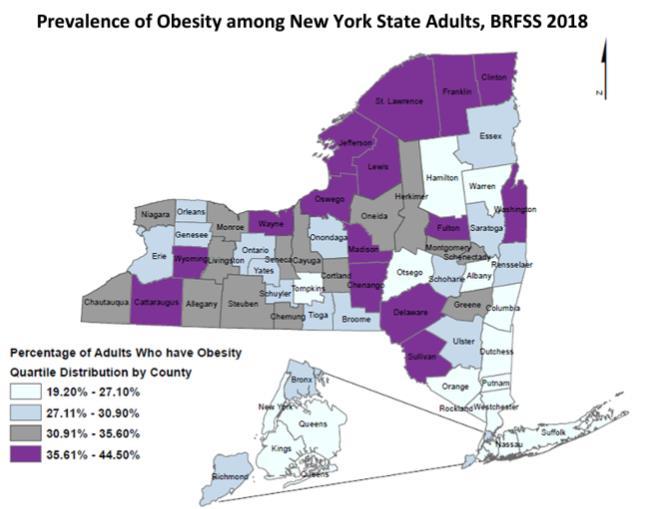
Source: New York State Behavioral Risk Factor Surveillance System (BRFSS). Overweight and Obesity, 2018. https://www.health.ny.gov/statistics/brfss/reports/docs/2003_brfss_overweight_and_obesity.pdf
Another health disparity identified in primary and secondary research is adult obesity Nassau County continues to experience high rates of obesity and overweight adults. Twenty three percent of the population (age 20 and older) reports a body mass index (BMI) greater than or equal to 30 kg/m.20 According to the New York State Department of Health, obesity is a significant risk factor for many chronic diseases including type 2 diabetes, high blood pressure, asthma, stroke, heart disease and certain types of cancer.
18 https://www.health.ny.gov/statistics/opioid/data/pdf/nys_apr22.pdf
19 https://www.health.ny.gov/statistics/opioid/data/pdf/nys_jan21.pdf
20 https://www.health.ny.gov/statistics/prevention/injury_prevention/information_for_action/docs/202102_ifa_report.pdf

The prevalence of chronic diseases is persistent in the county. Nationally, communities of color experience higher rates of chronic disease. Using diabetes as an example, the American Indian/Alaska Native population represents 14.5 percent of adults 18 or older who are diagnosed with diabetes followed by Black, non-Hispanic at 12.1% and Hispanic overall at 11.8% in the United States. Asians and Whites experience the disease at 9.5% and 7.4% respectively.
21 Health providers report that many individuals delayed preventive care and routine screenings due to the pandemic, leading to more complicated cases and unfavorable outcomes. Chronic diseases are preventable conditions sensitive to lifestyle (diet/physical activity) habits but hampered by the obstacles presented by social determinant of health factors - mainly income/employment, race/ethnicity, food access, housing/neighborhood location, and level of education to name a few. The county and hospitals identified in this report through collaborative efforts and facility-specific programming acknowledge and address these determinants regularly
These are the main health challenges and contributing causes affecting residents of the county, especially in low-income communities of color. That these social determinants of health are predictors of chronic disease is well documented.
22 23 24 Health care access issues are mostly tied to economics (quality of health insurance, employment, cost of
21 https://www.cdc.gov/diabetes/health-equity/diabetes-by-the-numbers.html
22 Cockerham WC, Hamby BW, Oates GR. The Social Determinants of Chronic Disease. Am J Prev Med. 2017 Jan;52(1S1):S5-S12. https://doi.org/10.1016%2Fj.amepre.2016.09.010. PMID: 27989293; PMCID: PMC5328595.
23 Pantell MS, Prather AA, Downing JM, Gordon NP, Adler NE. Association of Social and Behavioral Risk Factors With Earlier Onset of Adult Hypertension and Diabetes. JAMA Netw Open. 2019;2(5):e193933. Https://doi:10.1001/jamanetworkopen.2019.3933
24 Vennu, V., Abdulrahman, T.A., Alenazi, A.M. et al. Associations between social determinants and the presence of chronic diseases: data from the osteoarthritis Initiative. BMC Public Health 20, 1323 (2020). https://doi.org/10.1186/s12889-02009451-5
living). In the mental health/substance misuse space, access is further hampered by a dearth of providers. Fear, which includes immigration status, is also a detriment to health care access.
As the pandemic revealed, Black and Hispanic individuals experienced higher rates of COVID-19 disease and death. These higher rates correlated to low-income areas and the higher rate of chronic disease seen in these communities. According to the Centers for Disease Control and Prevention (CDC), chronic disease is a leading risk factor for COVID-19 morbidity and mortality. The 2021 National Healthcare Quality and Disparities Report25 notes that significant disparities still exist among racial or ethnic minority groups. Although the report’s most recent data reference is 2018, we can examine one chronic disease –hypertension – and extrapolate that in recent years the incidence has not improved. The report notes that the rate of hospital admissions for hypertension was 212.9 per 100,000 population for Black adults compared with 38.4 per 100,000 cases for White adults and just over 50 cases per 100,000 for Hispanics. The New York State COVID-19 Fatalities Tracker26 shows that the number one COVID-19 co-morbidity was and is hypertension.
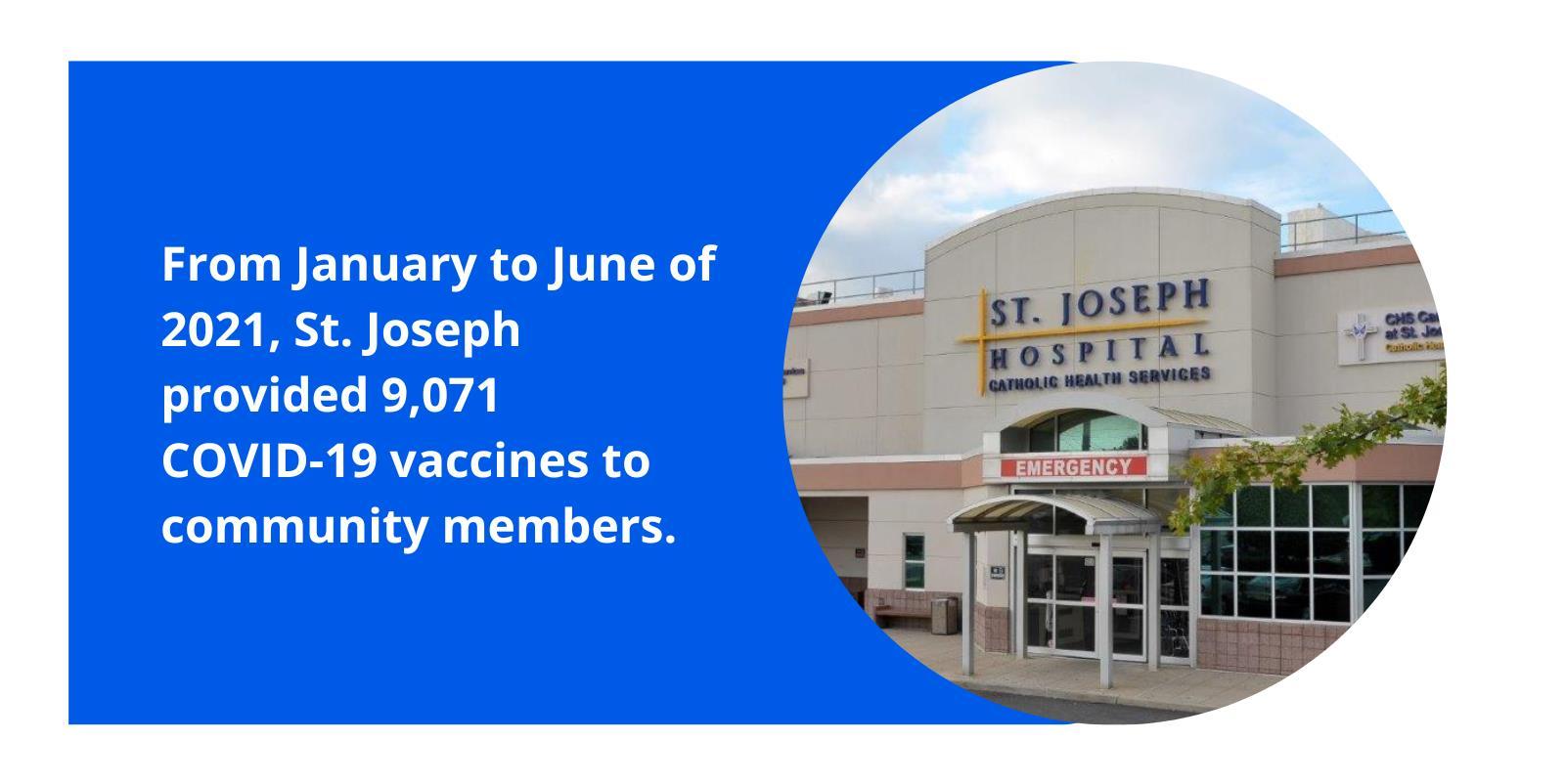
The Long Island Vaccination HUB, the entity charged by the state with ensuring equitable distribution of vaccines, tracked vaccine distribution by the week until the spring of 2022. Catholic Health participated in the HUB, holding point of distribution (POD) clinics at churches and other community venues. Among patients who tested positive for COVID-19, Black, Hispanic, and Asian patients remained at higher risk for hospitalization and death compared to White patients with similar socioeconomic characteristics and underlying health conditions, suggesting racism and discrimination may affect outcomes.27
25 https://www.ahrq.gov/research/findings/nhqrdr/nhqdr21/index.html
26 https://coronavirus.health.ny.gov/fatalities-0
27 https://www.kff.org/coronavirus-covid-19/issue-brief/covid-19-racial-disparities-testing-infectionhospitalization-death-analysis-epic-patient-data/

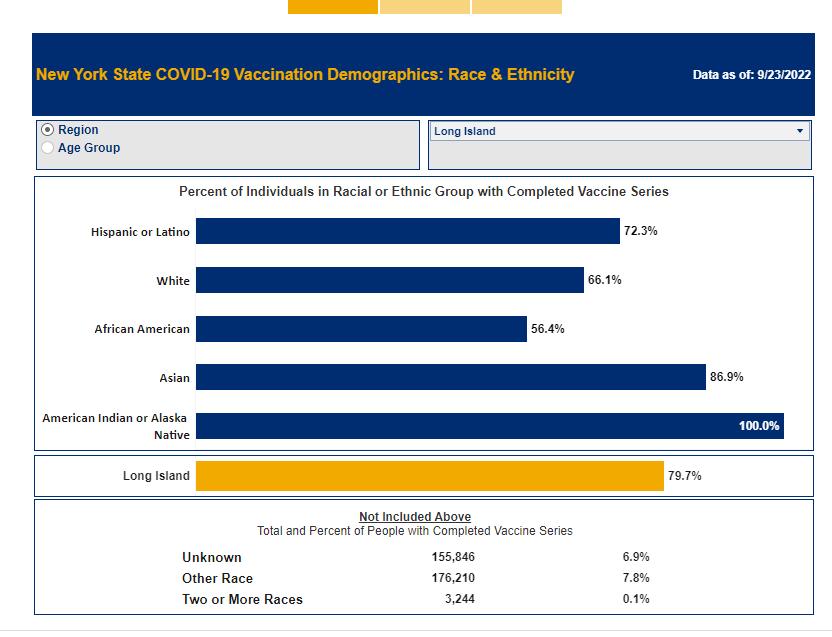
Source: Demographic Vaccination Data | Department of Health (ny.gov)
As of September 23, 2022, 72% of Latino adults, 66% of White adults 56% of Black adults have been fully vaccinated against COVID-19 in Nassau County. Ongoing partner efforts will continue to promote booster vaccines to eligible community residents
Guided by the LIHC, Catholic Health and all regional partners reviewed results from the two qualitative analyses and two quantitative analyses, our sources of primary data, and a variety of secondary data analyses provided by DataGen, which were drawn from national, state, and county publicly available datasets, as well as proprietary health determinant data metrics from Socially Determined, Inc.
The engagement process we used to select the two priorities was purposeful and collaborative. On April 5, 2022, at 8 a.m., the LIHC posted results of all its data analyses. The
members of the 2022 CHNA Workgroup were asked to review the results in advance of the priority selection meeting, which occurred on April 5, 2022, at 1 p.m. via Zoom. The data analyst walked participants through screenshots of the relevant findings. Participants also viewed the Prevention Agenda dashboard, diving deep into the goals, objectives, and recommended interventions for each priority. Present at the meeting were representatives from Long Island’s two health departments and representatives from Long Island’s hospitals/health systems, as well as staff of the LIHC. Attendees discussed primary and secondary data results and based the selection of priorities on the following criteria:
The overwhelming evidence presented by the data, especially the first two questions of the Community Health Assessment Survey
The activities/strategies/interventions currently in place throughout the region
The feasibility of achieving momentum and success with a chosen priority, taking into account the diversity of partners and community members served
Comments from community members and others regarding the previous CHNA
After an official vote, the priorities were selected unanimously. The April meeting was a culmination of seven LIHC work group meetings held each month, beginning in September 2021 and concluding in April 2022. At these meetings, in addition to representatives noted above, community-based organization leaders from a diversity of sectors offered input.
Engagement of the broader community, for assessment purposes, is achieved through the LIHC’s and its partners’ ongoing distribution of the Community Health Needs Assessment – the main primary research tool used to gauge community health needs, social support needs, and barriers to health care on an ongoing basis. This survey is offered online via a SurveyMonkey link and is available in paper format to residents at public events, workshops, educational programs, and interventions which are offered by St. Joseph and other LIHC partners. A paper version is also distributed among physician offices, hospital waiting areas, libraries, schools, federally qualified health clinics, insurance enrollment sites, and other public venues. The LIHC vigilantly promotes the survey through social media and asks LIHC participants to post the survey link on each of their websites. The LIHC provides a social media toolkit with an opportunity for co-branding to facilitate participation and St. Joseph has availed itself of this service St. Joseph posts this survey and the SurveyMonkey link on its website and in electronic and print community newsletters. The survey can also be accessed via a QR code. Results from the Community Health Assessment Survey are analyzed yearly. Findings are shared with all LIHC participants, with the media, and posted on the LIHC website. A certified translation of the survey is available in the following languages: Spanish, Polish, and Haitian Creole. Large print copies are also available to those living with vision impairment.
Engagement of the broader community, for implementation purposes, is assisted by the LIHC’s encouragement of community members to participate in programs, workshops,
support groups and educational programs offered by St. Joseph and all LIHC partners. In addition, the LIHC offers limited programming itself, such as the Walk Safe with a Doc events and Talk with a Doc events (presented in collaboration with AARP-LI). All LIHC quarterly meetings are open to the public and recordings of the meetings are housed on its website. The LIHC, on behalf of all its participants and the community members each participant serves, supports the following evidence-based activities and programs:
Awareness Campaign (Live Better) about chronic disease via social media and traditional media platforms (this campaign captures any mentions about chronic diseases and relevant programs/education efforts)
Awareness Campaign about mental health prevention and treatment programs/education, as well as relevant treatment and prevention programming relative to substance misuse via social media and traditional media platforms (this campaign captures any mentions about mental health/substance misuse programs/events/workshops, etc.)
Walk Safe with a Doc are community walking events that combine pedestrian safety education with chronic disease education all while walking. The LIHC maintains an active Walk with a Doc chapter for the region.
Talk with a Doc are Zoom-delivered educational programs led by physicians from the region’s hospitals covering a variety of chronic diseases.
When they first gathered in 2013, LIHC partners embraced walking as a simple, low-cost, easy activity that most anyone of any age can perform. Walking is an evidence-based intervention that offers proven benefits to one’s physical and mental health. The Walk with a Doc chapter is the activity through which LIHC, and its partners promote the health benefits of walking. See Research and Supporting Evidence in Appendix H. Collaborative participants rely upon LIHC’s use of social media and traditional media to cross-promote collaborative partners’ programs, interventions, events, workshops, etc., as well as general messaging about healthy lifestyle behaviors (physical activity and proper nutrition). Awareness campaigns use best practices for message conveyance. There is evidence as to the user engagement and sustainability effects of social media and mass media regarding health messaging. Investigation in this area is ongoing (See Research and Supporting Evidence in Appendix H) The Community Guide, a website that houses the official collection of all Community Preventive Services Task Force findings and the systemic reviews on which they are based, was also referenced.28
Catholic Health obtained population level and zip code analyses on social determinant of health drivers and health/risk factors dominant in Catholic Health’s service area from its data partner, DataGen. We also looked at hospital utilization data and emergency department data to discern top diagnoses. A survey completed by individual community members, a similar survey completed by community-based organization leaders, key
28 https://www.thecommunityguide.org/
informant interviews with selected leaders, and the results of qualitative research among public library personnel rounded out the research for this cycle’s CHNA. The CHNA approach used both quantitative and qualitative research methods designed to evaluate the perspectives and opinions of stakeholders and health care consumers. The methodology helped develop a broad, community-based list of needs in addition to prioritizing the needs and establishing a basis for continued community engagement.

Quantitative Methods and Research Tools (See appendix for full reports and tools)
Community Health Needs Assessment Survey (CHAS) – measured individual and community level perception of health needs and barriers. A total of 1,143 were completed during the period of January 2021 – December 2021. A subsequent analysis particular to the zip codes in the St. Joseph service area was completed by analyzing 439 surveys collected during the period January 2022 – August 2022. The CHAS provides a snapshot in time of the main health challenges facing communities. It uses the SurveyMonkey platform. Convenience sampling method.
CBO Community Needs Assessment Survey – community-based organization (CBO) leader perception of health needs and barriers faced by their constituents/patients. A total of 44 surveys were completed (10 from Nassau County, 25 from Suffolk County, 9 with no location specified). The survey was distributed to 400 plus leaders during the time period December 1, 2021 - January 15, 2022. It uses the SurveyMonkey platform. Purposeful sampling method.
Qualitative Methods and Research Tools (See appendix for full reports and tools)
CBO Key Informant Interviews – of the 44 CBO leaders who completed the above-mentioned CBO community needs assessment, 23 agreed to a follow-up in-depth interview and 12 actually participated. The interviews were conducted February 23, 2022, to March 4, 2022, via Zoom and recorded. Atlas Ti version 22 web-based platform used for grounded-theory analysis.
Library Research Project – a two-year study providing an insider look at the health and social support needs of patrons who frequent Long Island’s public libraries. Library personnel at randomly selected libraries throughout Nassau County were selected for this study. A total of 96 interviews (Nassau and Suffolk County libraries) were conducted during the time period December 2017 to February 2020. Interviews were recorded, then transcribed, and analyzed using Dedoose qualitative software (grounded theory) for recurring themes with the report “Long Island’s Libraries: Caretakers of the Region’s Social Support and Health Needs” issued July 2021. Stony Brook University Program in Public Health researchers and students completed the analysis. The analysis considered the socioeconomic differences of communities by location, the influence of social determinants of health, and the Prevention Agenda priorities.
The secondary data research included a thorough analysis of previously published materials/metrics that provide insight regarding the community and health-related measures.
SPARCS (Statewide Planning and Research Cooperative System) – analysis of hospitalization data 2018, 2019, 2020.
Emergency Department Visits – analysis of Saint Joseph’s emergency department visits during the time period July 1, 2021, to June 30, 2022, to discern top diagnoses.
Socially Determined, Inc. social risk analytics spanning 200 metrics drawn from a variety of publicly available national, state, and county datasets. Zip code and census track level data.
Data from both the primary and secondary research methods revealed the following key themes Primary data survey results from hundreds of Nassau County residents reveal obesity, mental health, women’s health and drug and alcohol usage, cancer and diabetes as the top concerns for 2022.


In the above charts, survey respondents answered what their community and individual health concerns are from their perspective. We then compared to annual results from 2019, 2020, 2021 and January – August 2022. The results represent survey responses over three years and eight months for identified health concerns. We focused on the most current results 2022. There is a significant increase in 2022 for mental health, cancer, obesity, depression/suicide and drugs and alcohol abuse by survey respondents regarding their perception on the biggest ongoing health concerns in the community. Further, when answering questions about individual health, survey takers indicated mental
health/depression again along with obesity/weight loss issues, safety, diabetes, and women’s health and wellness.
The responses in the charts below highlight similar themes. In what prevents community members from accessing care, responses ranged from language barriers, to fear of seeing a provider, to the cost of care. Poverty and economic distress were also identified in community key informant interviews. Survey responses for what services are most needed to improve the health of the community highlight clean air and water, rehabilitation services for drug and alcohol abuse, healthy food choices and mental health services.
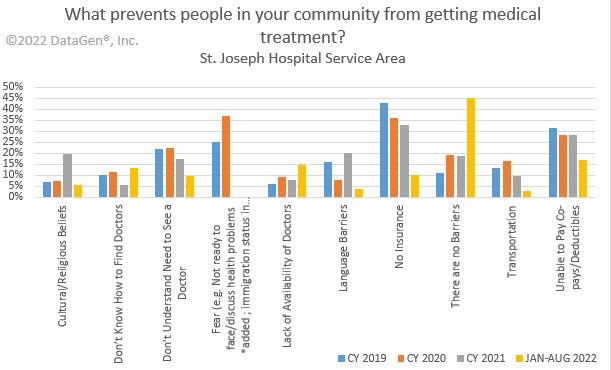
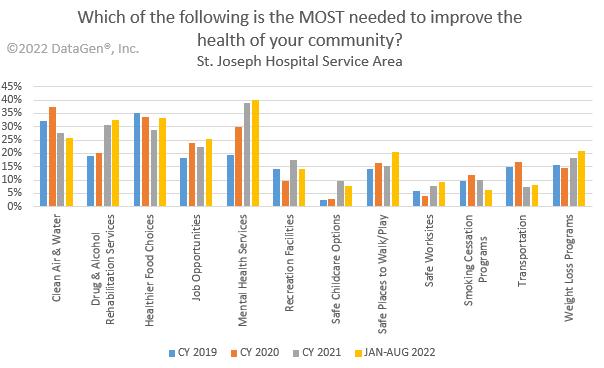
The below chart highlights the needs of community members in important health education services. Top needs include substance abuse services, mental health, exercise and physical activity, dental screenings and chronic disease management, such as blood pressure and well checkups.

SPARCS is a comprehensive all payer data reporting system established in 1979 as a result of cooperation between the health care industry and government. The system was initially created to collect information on discharges from hospitals. SPARCS currently collects patient level detail on patient characteristics, diagnoses and treatments, services, and charges for each hospital inpatient stay and outpatient (ambulatory surgery, emergency department, and outpatient services) visit; and each ambulatory surgery and outpatient services visit to a hospital extension clinic and diagnostic and treatment center licensed to provide ambulatory surgery services.
In addition to examining the local resident feedback of identified health needs and concerns, Catholic Health also examined Nassau County inpatient hospital data for the last
29 https://www.health.ny.gov/statistics/sparcs/
three years. Hypertension, heart disease, diabetes, cancer and mental health services all correlate to the Catholic Health’s and St. Joseph’s priority areas.

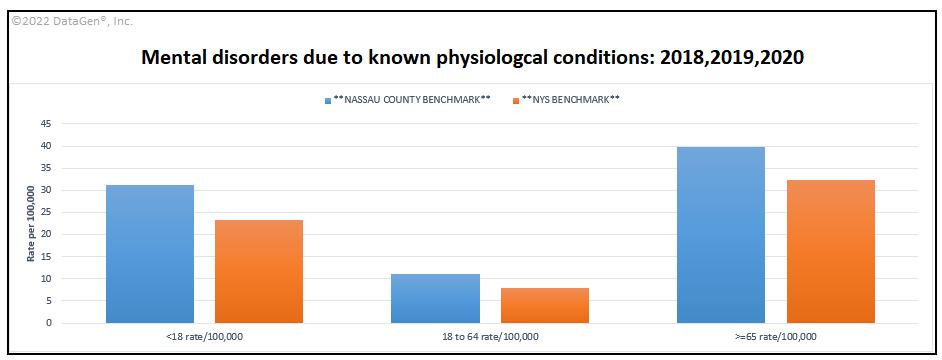


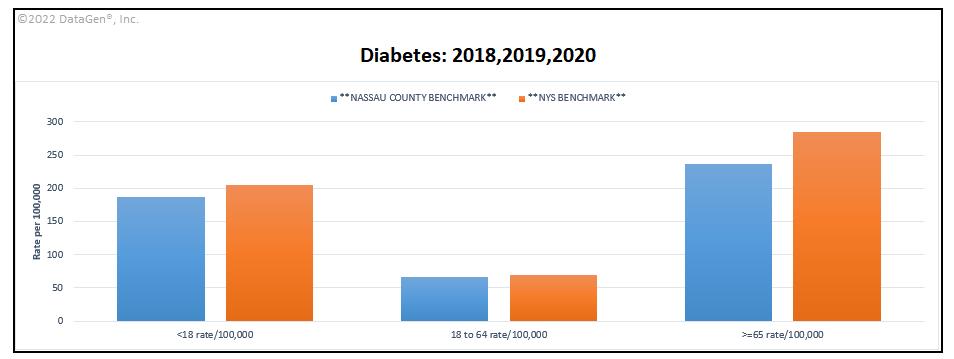
In examining hospital inpatient data for Nassau County 2018-2020, hypertension and diseases of the heart have increased over recent years validating the Community Health Assessment Survey feedback. The incidence is greatest in the 65 plus population, although some improvement was gained by 2020. The data indicates that the rate of diagnoses for mental disorders has increased in 2020 with highest incidence seen among the 65+ population, followed by the under 18 population. This last finding correlates with state and national research identified in this report about the significant increase in mental health issues experienced by our youth.
Nassau County also fares worse for the incidence of cancer among all age groups compared to the state benchmark. Once again we see the 65 plus population is the hardest hit. The rate of diabetes seen in Nassau County is below the state benchmark. The 18 to 64 population is just about at the state benchmark, leading providers like St. Joseph to be wary of increasing incidence of this disease and its complications, as residents age.
In examining one year of emergency department data at St. Joseph, the primary visits in the last year are for COVID-19, chest pain, injury and hypertension.
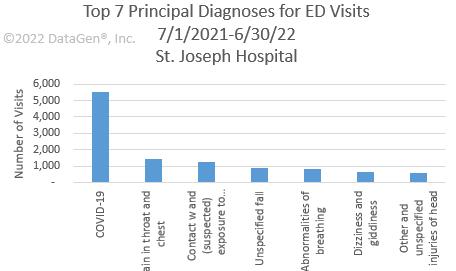

Emergency room data for St. Joseph shows over 37,328 visits from July 2021 to June 2022. Uninsured encounters account for 849 visits. Top ICD-10 diagnosis codes reveal the impact of COVID-19 on the community’s health, along with cardiac health, and hypertension, and related chronic diseases.

What would be most helpful to improve the health problems of the people/community you serve?
The results from these two particular questions reveal that CBO leaders are concerned about food access for their clients and mental health services. They also continue to see drug and alcohol abuse, mental health, and issues related to nutrition and weight loss as major health concerns for their clients.
The top three social determinant of health factors found via this analysis are education, healthcare system (in terms of access) and food. Kaiser Family Foundation Social Determinant of Health domains used as reference.30






Health care access followed by education and programs/services were the top three codes that emerged from among the transcripts.

30 https://www.kff.org/racial-equity-and-health-policy/issue-brief/beyond-health-care-the-role-of-socialdeterminants-in-promoting-health-and-health-equity/

Library personnel at randomly selected public libraries throughout Nassau County were interviewed for this study. Mental health is the top health need identified followed by exercise and diet, two lifestyle behaviors that exert a tremendous influence on the incidence of all chronic diseases. Homelessness took the top spot among social needs, possibly because public libraries, especially in low-income, high-need communities, are a haven for the disenfranchised
In addition to working directly with the Long Island Health Collaborative, St. Joseph has strong relationships with local and regional community-based organizations, libraries, schools, faith-based organizations, the local health department, local fire departments and municipalities that support and partner with us to reduce chronic disease, mental health and substance misuse, and to promote health equity. See page 9 for our extensive partner list of health care and other key institutions. A shortlist of available assets and resources includes:
Each partner offers unique programming and interventions that align with the goals and objectives of Saint Joseph’s. These assets and resources can be mobilized and employed to address the health issues identified. See the work plan in the appendix E for a detailed description of interventions and our partners with whom we are working.
In support of our Community Service Plan, during the past three years, St. Joseph partnered with community-based organizations in multiple communities to hold culturally relevant chronic disease management educational programs, vaccination clinics, support groups, health screenings, emotional wellbeing workshops, and lectures among other outreach activities. Due to the COVID-19 pandemic, many outreach activities traditionally held in the community were paused in March 2020 but resumed in the fall of 2021. With lessons learned, many successful virtual education events still continue.
Mission moment highlights (Represents community outreach activities for years 2020, 2021, and through August 2022):
Screenings (Outreach Bus, Health Sundays Program, Other Locations): 232 individuals
Vaccination Clinics and PODS: 9,071 administered
Community Lectures/Workshops: 5,601 attendees
Trainings (CPR, Stop the Bleed, Narcan): 133 individuals trained
Support Groups (Condition Specific): 3,112 attendees
Support Groups (Behavioral Health): 46 attendees
Blood Drives: 290 donors
Evidence-based interventions
St. Joseph remains committed to providing the community with evidence-based and promising practice programs that address chronic diseases and mental health/substance misuse. Additionally, as a faith-based provider, it has always been our mission to address the social needs of our patients and community members. Our interventions are broad and far reaching. Refer to our work plan for specific interventions, measures, partners, goals and objectives.
Work plan
See appendix E
This report is a comprehensive study of the health needs and barriers experienced by the community members served in this region. After extensive research and interaction with partners and the public, the following priorities were selected:
1. Prevent Chronic Disease
Focus Area 4: Chronic Disease Preventive Care and Management
2. Promote Well-Being and Prevent Mental and Substance Use Disorders
Focus Area 2: Mental and Substance Use Disorders Prevention
The public needs to understand the findings of this report and Catholic Health’s vision for meeting these priorities and closing the gap in health disparities.
This report is being made available to the public and will be posted on Catholic Health’s website.
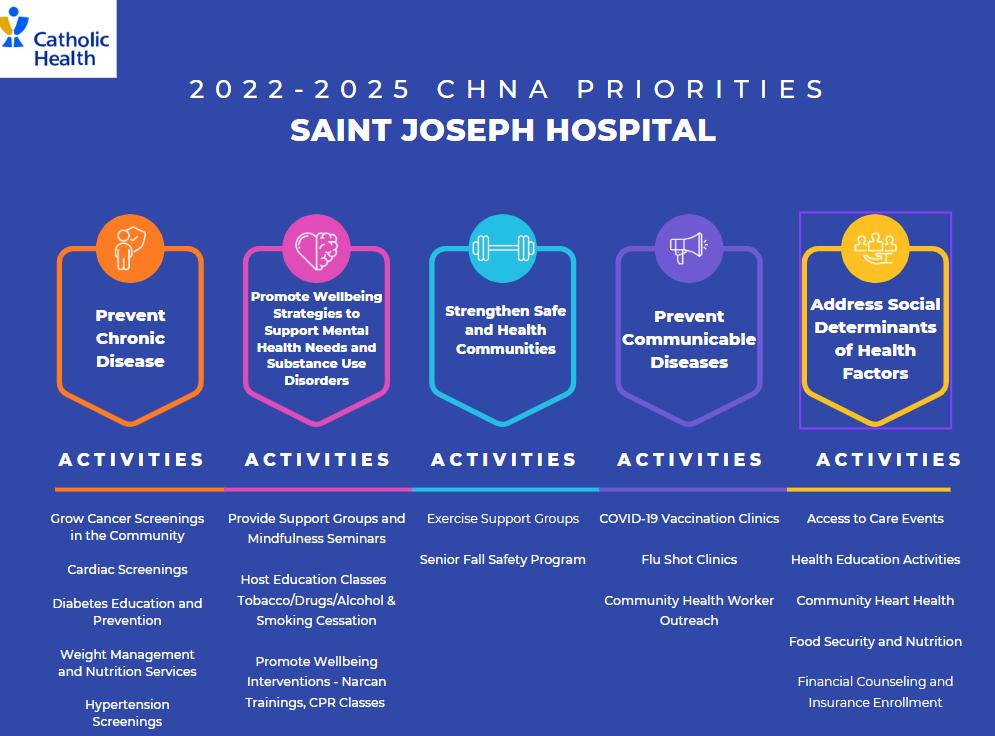
This CHNA and resulting implementation plan meet the 501(c)(3)(r) federal requirements for conducting a CHNA and implementation plan. The regulations are part of the Affordable Care Act and became effective in 2015. The document also meets New York State guidelines for community health needs assessments and community involvement.
Catholic Health is pleased to provide this comprehensive report to community members and the wider public. It reaffirms each organization’s commitment to meeting the health needs of our communities and working every day to mitigate health disparities. Targeted interventions and strategies, driven by the data outlined in this report, reflect meaningful and reasonable approaches to improving the health of our communities during the next three-year cycle, 2022 - 2024. We will report on the status of these interventions and strategies throughout the implementation period.
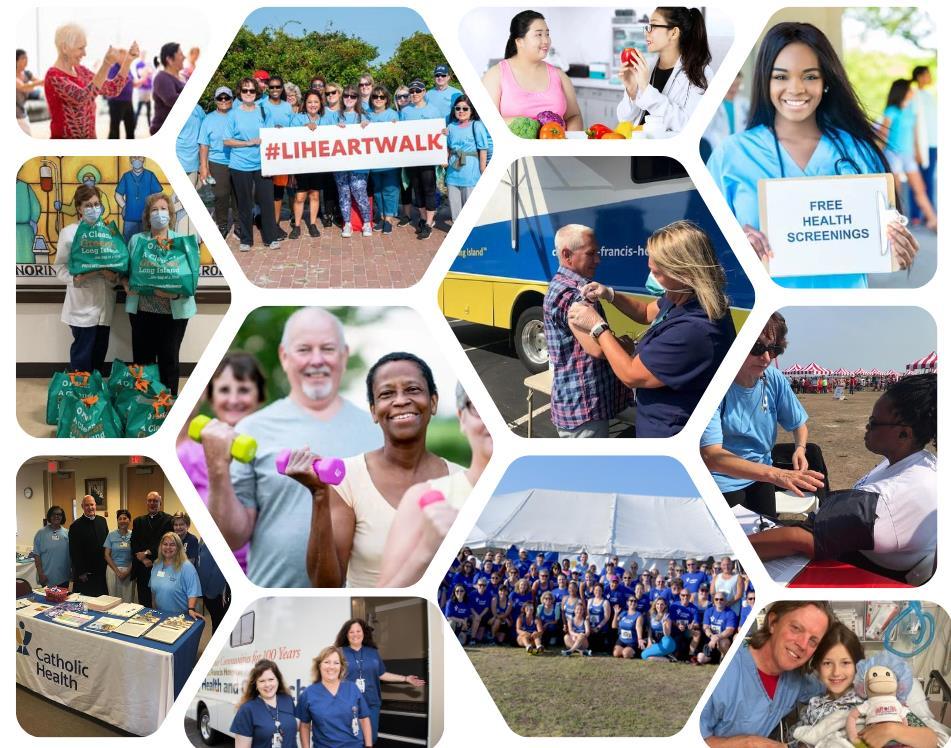
Priority
Prevent Chronic Diseases
Focus Area (select one from drop down list)
Focus Area 1: Healthy eating and food security
Prevent Chronic Diseases
Focus Area 4: Preventive care and management
Goal Focus Area (select one from drop down list)
Goal 1.2 Increase skills and knowledge to support healthy food and beverage choices
Prevent Chronic Diseases
Focus Area 4: Preventive care and management
Goal 4.4 In the community setting, improve self-management skills for individuals with chronic diseases, including asthma, arthritis, cardiovascular disease, diabetes and prediabetes and obesity
Goal 4.4 In the community setting, improve self-management skills for individuals with chronic diseases, including asthma, arthritis, cardiovascular disease, diabetes and prediabetes and obesity
Prevent Chronic Diseases
Focus Area 4: Preventive care and management
Prevent Chronic Diseases
Focus Area 2: Physical activity
Goal 4.3 Promote evidence-based care to prevent and manage chronic diseases including asthma, arthritis, cardiovascular disease, diabetes and prediabetes and obesity
Goal 2.1 Improve community environments that support active transportation and recreational physical activity for people of all ages and abilities.
1.4 Decrease the percentage of adults 18 and older with obesity (among adults)
Disparities Interventions
Low-income communities of color
Live Better Awareness Campaign
Health education for local EMS providers covering timely health care updates on cardiac disease, stroke and other relevant topics.
Program is free and available to providers who serve all community members.
EMS staff earn
2 CME credits for lecture
Offer lectures and speakers bureau in the community, including disease self-management and wellness, targeting local underserved communities.
Free community health fair providing opportunities for participants to speak with a breast surgeon, cardiologist, foot specialist, sleep apnea specialist, asthma specialist, physical therapist and wound care physician
1.7: Increase the percentage of adults 18 years and older who participate in leisure-time physical activity (among all adults)
Vulnerable senior populations in the local community.
Free education and workshops on chronic disease, health and wellness.
The health fair is free and available to all community members.
Health fair providing education to the community and an opportunity to meet with clinical staff.
Low-income. Communities of color Walk Safe with a Doc
4.3.11 Increase the percentage of adults with HTN who are currently taking medicine to manage their high blood pressure and 4.3.12 Increase the percentage of aduith arthirits who have been told be their doctor or health professional to be physically active/exercise to help with arthritis or joint symptims by 5%
Low-income communities of color Talk with a Doc
Process Measures: Number of clicks dedicated web page;number chronic disease video downloads; all relevant social media platform analytics (posts, egagements, mentions) and number earned media mentions. Intermediate measures: observed increase in social media traffic and media requests. Outcome measurses: Region-wide reduction in hospital admissions for type 2 diabetes
Process Measures: Number of talk events, number of attendees.
Intermediate measures: Knowledge gained pre and post survey.
Outcome measures: reduced blood pressure, reduced joint pain, more people walking for exercise
10 number of talk events held and analyzed all pre/post event data Hospitals
Partner Role(s) and Resources
Provision of air time/print space
Partners include local EMS providers who promote the event to their members.
Partners include local senior organizations and their members.
Consumers attend event
Pedestrian safety expertise
Physician expertise
St. Joseph Hospital (Catholic Health) 2023 Workplan
Planning Report
Liaison Elizabeth Schwind
Email: Elizabeth.schwind@chsli.org Priority
Focus
Promote
Goal
Enable Patient and Family Advisory Committee to recommend policy and program interventions to help hospitals provide care and services that are based on patient and familyidentified needs. Partners: selected community members serve on hospital committee.
Members represent all populations. Patient and Family Advisory Committee actions on behalf of patients and families.
Educate healthcare professionals on the specific and varied needs of the opioid addicted population, provide resources as well as training on compassion for this population.
Healthcare professionals are educated on the specific needs of patients with addiction and dispel myths associated with this disease.
Offer an education conference for health care professionals.
Partner Role(s) and Resources
Partners: selected community members serve on hospital committee.
Partners include providers with expertise on this population of patients.
Equip children with basic first aid techniques. Partner: Girl Scouts of America
First aid training is essential for all children; Scouting programs are open to children from all communities at low or no cost.
Conduct a first aid lecture and handson demonstration to establish basic first aid techniques with children. Program also enables scouts to achieve a first aid badge.
Partner Role(s) and Resources Schools and Girl Scouts of America to promote lecture to students/scouts
Increase breastfeeding rates. Hospital lactation consultant meets with new mothers to provide breastfeeding education and support.
Educate expectant mothers on women's health and wellness and infant care.
Disparities
Breastfeeding rates differ among racial/ethnic groups.
Low-income families who may not have access to care and/or wellness education.
Interventions
Provide access to professional breastfeeding support at the hospital to reduce barriers to breastfeeding, especially for low-income families.
Conduct one Best Baby Shower event for families who may not have access to care and wellness education.
Family of Measures
# of women exclusively breastfeeding their babies since birth.
By December 2023, we will have completed . . .
Implementation Partner
(Please select one partner from the dropdown list per row)
Work with mother/baby unit staff to increase BF rates. Hospital
# of attendees participating in event 1 event Hospital
Partner Role(s) and Resources
Hospital to provide professional breastfeeding support
Partners: hospital staff and community participants
St. Joseph Hospital (Catholic Health)
2023 Workplan
Planning Report Liaison Elizabeth Schwind
E-mail: Elizabeth.Schwind@chsli.org
Intervention 1.2.2 Offer vaccines in locations and hours that are convenient to the public including pharmacies, vaccine only clinics, and other sites that are accessible to people of all ages. Partners: churches, houses of worship, community and civic organizations.
Those without access to or ineligible for health care.
The hospital will offer free flu Vaccinations in underserved communities at community events, Healthy Sundays, hospital health fairs and other community venues
Family of Measures
By December 2023, we will have completed . . .
# of free flu vaccinations given Project more than 700 flu vaccinations provided through the St. Francis outreach bus and 400 vaccinations at the 6 scheduled Healthy Sundays events.
Implementation Partner (Please select one partner from the dropdown list per row)
Partner Role(s) and Resources
Partners: churches, houses of worship, community and civic organizations.